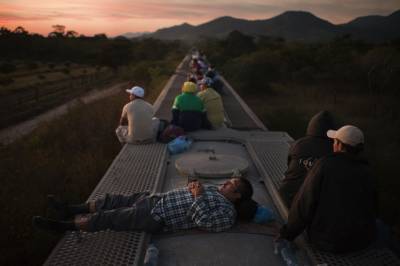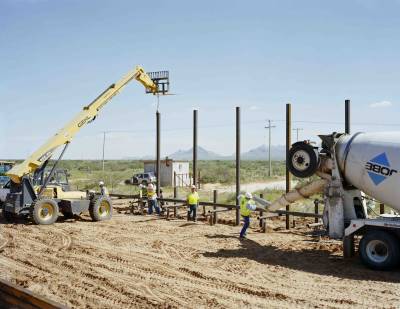La Frontera: The cultural impact of Mexican migration

About the Exhibition
The idea for this exhibition originated a few years ago when I was invited to be a member of the Mexican Community Roundtable of the Chicago Council on Global Affairs. I learned that there are many layers and generations of migration from Mexico to Chicago. Representatives of this history at the table had a wide variety of agendas and degrees of mutual understanding and tolerance or intolerance. All of this was quite different from the simple, commonly held notions of migration and immigration promulgated by the news media in the U.S.
Having worked within the arts community in Mexico for many years, I decided to create an exhibition that would explore some selected layers of cultural impact on both sides of the border of the movement of people from Mexico to the United States. The hope is that specific, personalized photographic projects might be an antidote to the harmful abstractions and over simplifications in the media.
This is, of course, a very large subject and difficult to deal with briefly. Currently the issues addressed by this exhibition have accelerated in importance in the United States due to increased (and often racist) public and legal involvement, specifically focused on laws passed in various states to facilitate the deportation of illegal aliens. While comprising, by most estimates, only a little over half of the illegal population, Mexicans are portrayed as the whole problem. The economic downturn in both Mexico and the U.S. has reduced the number of attempted illegal entries simply because there are fewer jobs north of the border.
Also inextricably connected to illegal immigration in the U.S. public’s mind is the current drug trafficking and drug related violence and political breakdown in Mexico. Politicians in Arizona, including John McCain who previously courted the Hispanic vote for his presidential bid, rhetorically associate all Mexican migrants with drug traffic, kidnapping and gun violence. Former Mexican president Vicente Fox, in a recent New York Times interview, pointed out that the increasing number of criminal drug families and the gun violence in Mexico were both absolutely caused by the huge U.S. drug and weapons markets.
Juan Pacheco (U.S., 1946) deals with the issue of race, and often racism, connected to immigration, something at the center of national debate in the U.S. at the moment. “As a man of color one is often reacted to as a threat within the mainstream community. Consequently, my current work is concerned with perception and how racial stereotypes are processed using the photographic image,” he explains. His series of portraits are partially masked, suggesting the ignorance at the core of racism.
The border is the choke point for all of these issues. While American politicians fantasize, and ask us to join them, about building a fence from Matamoros on the Gulf of Mexico to Tijuana on the Pacific, illegal migrants in search of work, some carrying children, walk the same trails as smugglers carrying sixty pound back packs of drugs. The western desert border areas are deadly to some. The Devil’s Highway: A True Story (Little, Brown, 2004) by Luis Alberto Urrea documents this all too common tragedy. The Pima County Morgue in Tucson, Arizona is presently full to overflowing with unidentified bodies found in the desert.
An aspect of the border that has not been in the news is the phenomenon of the “Maquiladoras,” factories built by U.S.businesses on the Mexican side of the border to take advantage of cheap labor. There are a number in the town of Juárez, a recent focal point of violence. They provide low wage employment for Mexicans but also cause overpopulation and consequent social and cultural shifts in the host towns. Yoshua Okon uses irony and humor, two elements in short supply in the culture of the maquiladoras. His installation asks us to imagine a foreign factory that produces canned laughter.
David Taylor (U.S., 1965) has been exploring and recording the dynamics of the border including the various layers of immigration control and border guards, humanitarian groups, Minute Men and illegals for four years. He has just published a book titled Working the Line (Radius Books, 2010) that records his extensive experience traveling with the Border Patrol, primarily in the Texas and New Mexico border areas. He has also recorded the border itself, some of which is fenced, marked with stone monuments erected in the 1890s by the International Boundary Commission between the Rio Grande and the Pacific. Taylor has become increasingly respectful of the guards on the U.S. side as they aggressively track armed drug runners while at the same time dealing humanely with illegal migrants.
Michael Hyatt (U.S., 1946) has concentrated on the physical evidence of undocumented workers and illegal migrants along the Sonora Desert border area of Arizona. He has worked on both sides of the border recording objects, with and without their human owners, that suggest wider stories in very human terms, including real suffering and death. The project resulted in the book Migrant Artifacts: Magic and Loss in the Sonoran Desert (Great Circle Books, 2007).
The routes to the border in Mexico are collectively called “El Camino Real,” an ironic reference to the 17th century route from Mexico City to California that covered the same ground. Entire cultures line this road, some illegal and exploitative of the people desperately seeking work in the north. This situation is exacerbated by the increasing volume of drug trafficking that is permanently changing many of the cultural parameters of Mexico, here and elsewhere, for ever. David Rochkind’s (U.S., 1980) project, Heavy Hand, Sunken Spirit, specifically explores evidence of this change.
As William Finnegan points out in his New Yorker essay of May 31st, 2010, “Silver or Lead,” there is a religious aspect to the drug families and those working for them. Rochkind has documented the veneration of Santa Muerte (Saint Death) and San Malverde, neither sanctioned by the Catholic Church. This seems at odds with the extreme violence used by the drug families as revenge or warning. Ironically, as the older corrupt political system is dismantled for good reasons, in some areas the vacuum left is being filled in by the powerful drug lords who replace the rule of law with the rule of arms.
The new daily life on the north side of the border for migrants and the old life left behind on the southern side are seldom acknowledged by the press on either side. An example is the town of West Liberty, Iowa that has been home to Mexican farm and agricultural factory workers since the 1940s, almost all of whom came from the town of Allende in the Mexican state of Durango. Unlike previous waves of immigrants to the U.S. in the 19th century, from Ireland for example, who had no desire to return, there is constant contact between the two towns. Andy Kropa (U.S.,1976) has done an extensive photographic project on the well integrated West Liberty.
Another example of the effects of migration, this one less positive, is the town of San Miguel Amatilan, in the state of Oaxaca. Here women have been forced to take over traditional male occupations such as building houses of adobe, mainly because the majority of the men have moved to the U.S. in search of work and many have not come back. Marcela Taboada (Mexico, 1960) has done a project on this town called Women of Clay.
The effects of migration are massive in places like Los Angeles and Chicago. The population of Mexican Americans began to grow here in Chicago during the World’s Columbian Exposition in 1893 and has not stopped. It is now the second largest in the country. Paul Taylor, the sociologist later married to social documentary photographer Dorothea Lange, studied the effects of Mexican immigration on labor practice in Chicago in the 1930s. The family of Antonio Perez (U.S., 1963) arrived in Chicago in the 1950s. He has lately been covering immigration issues in his capacity as photographer for the Chicago Tribune. In the early 1980s he documented the Mexican communities here for the book and exhibition Changing Chicago (University of Illinois Press, 1989). The family of Heriberto T. Quiroz (U.S., 1989) has been in the U.S. one generation also, since the 1980s. Many of the details Quiroz chooses to record are traditions with their source in Mexico. But they are contextualized by his knowledge of growing up in Pilsen, a Chicago neighborhood originally the home of Czech immigrants in the late 19th century.
The last word goes to Ben Sáenz (U.S., 1954), a poet living at the crossroads of the current crisis in Juárez, a town just across the border from El Paso, Texas. It is the site of the worst violence in the wars between various drug families. Counter to what some U.S. politicians and journalists would have us believe, the violence has not crossed the border. But anxiety about it has. Also, many families on the Mexican side have escaped to El Paso or to other areas of Mexico contributing further to cultural change. This is an excerpt from his poem, “Ode to Juárez No. 4, Martin Luther King Day, 2010”:
“next to the university where all the cars stop for red lights where everything is all order nobody knows anything about anybody who is that boy with the sign is his family kidnapped how many mother father sister baby brother who why what is the real story the woman next to me talking on her cell as her son stares out the window dreaming of and I drive away and why didn’t I stop and ask what the real story was why didn’t I ask because I fucking don’t want to know write something beautiful I have a dream and you have a dream and we all have another beautiful lie that will help us forget that Juárez is alive and well—and living in El Paso.”
—Rod Slemmons, MoCP Director
Image Gallery

